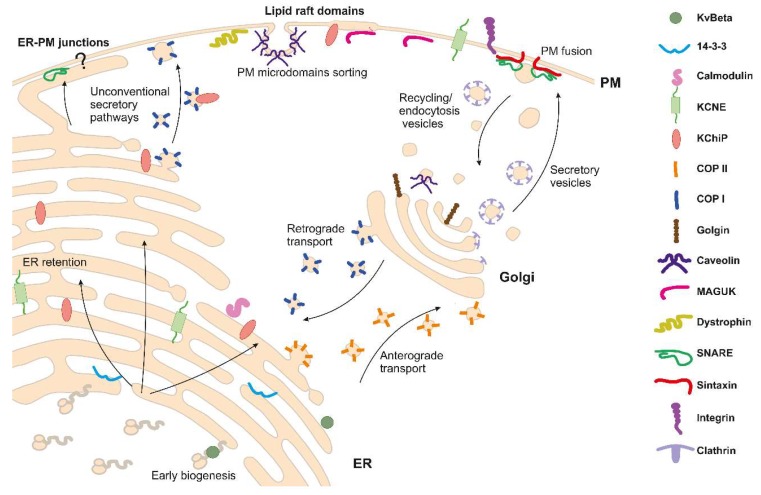Figure 2.
A schematic representation of traffic mechanisms and molecular associations of K+ channels through the secretory pathway. Different shapes represent molecules (see list on the right) known to associate with channels in different compartments. Channels are not depicted. Arrows represent major directions of either retrograde or anterograde routes. Newly synthetized peptides, bearing endoplasmic reticulum (ER) signatures, translocate to the rough ER where the association with Kvβ regulatory subunits takes place in early steps of the biogenesis. Different interactions and motifs balance between forward traffic or ER retention. Regulatory subunits, such as KCNEs, and accessory molecules, such K+ channel-interacting protein (KChiP), 14-3-3, or calmodulin, interact with channels at this step. Conventional mechanisms dictate that regardless of whether anterograde traffic is promoted, cargo channels are processed along the COPII machinery driving to Golgi. Once in Golgi, channels either forward traffic to the cell surface or undergo retrograde transport to ER via the COPI pathway. Molecules, such as Golgin, caveolin, or clathrin facilitate channel routes to the surface. Accessory molecules, such as MAGUK, dystrophin, syntaxin, integrins, or caveolins stabilize channels at the final destination (e.g., lipid raft microdomains and caveolae represented by a thicker part of the membrane and an invaginated omega-shaped structure, respectively). Turnover mechanisms, such as internalization, are mostly mediated by clathrin-coated pit-dependent endocytosis. Alternatively, unconventional pathways are also facilitated by auxiliary subunits assembling the channels. Thus, export from ER via COPI vesicles requires KChiP interaction. Direct contacts with the plasma membrane (PM) and further stabilization with SNARE at the ER–PM junctions are documented. However, most proteins implicated in this unconventional traffic remain unknown. It is important to highlight that mechanisms could differ depending on the KCh and the interacting protein. See text for further details.

